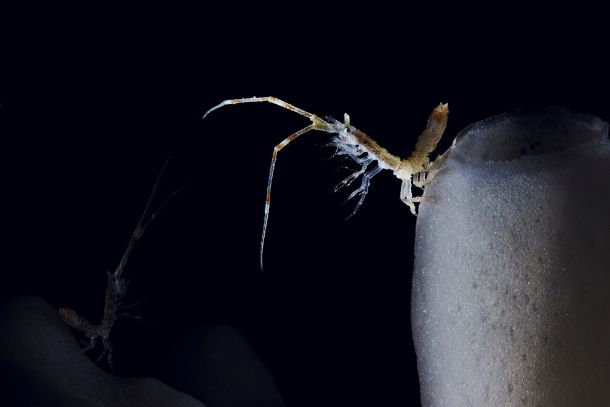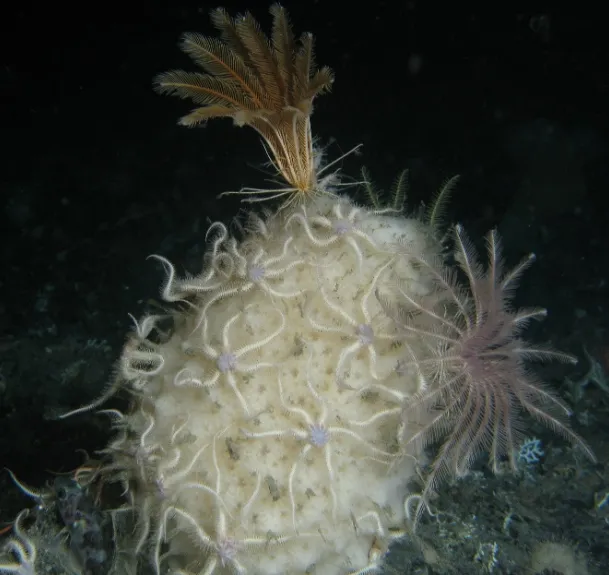Glass Sponges Move In As Antarctic Ice Shelves Melt
Typically slow-growing glass sponge communities are popping up quickly now that disappearing shelf ice has changed ocean conditions around Antarctica
/https://tf-cmsv2-smithsonianmag-media.s3.amazonaws.com/filer/20130711111136suspension-feeder-community-jgutt-small.jpg)
When most people think about organisms growing on the seafloor around Antarctica (if they think of them at all), a few short words come to mind: cold, slow, and dull. But under the right conditions, seafloor life on Antarctia’s continental shelf can grow very quickly, according to new research published today in Current Biology. The collapse of ice shelves in the Antarctic over the past two decades due to warmer waters bathing their undersides has already changed seawater conditions enough to allow typically slow-growing communities of glass sponges to sprout up under the more transient sea ice that has replaced the shelf.
“These things aren’t as unexciting as we thought; they are actually very dynamic,” says polar ecologist James McClintock of the University of Alabama, who was not involved in the research. “The idea that they could recruit and grow rapidly when these ice shelves break up is exciting, and suggests that the seafloor is going to change more quickly than we imagined.”
Glass sponges are the architects of the most diverse community on the seafloor under ice shelves. Like corals, glass sponges provide habitat for many other organisms. Their basket-like inner cavities are rare nurseries in the cold water, and small marine isopods, juvenile starfish, brittle stars, and even fish eggs have been found inside. As they die, they leave behind silica mats meters deep on the seafloor, providing prime substrate for crinoids, anemones, and other sponges to settle and grow. Also like corals, glass sponges grow slowly. Most grow only two centimeters each year, which makes the largest ones hundreds of years old.
Food scarcity is the reason for this slow growth. Antarctic waters have a very short growing season just weeks long, when sunlight and warmer water foster blooms of phytoplankton. During this brief period, phytoplankton feeds zooplankton, and waste products from the latter organisms feed bacteria and animals (like glass sponges) that filter particles and bacteria from the water. Even how much of that bounty an animal receives depends on whether it has settled in a current carrying food–or if those manna-bringing currents are blocked by ice. That said, it’s no surprise that, with so little food available, most organisms on the seafloor grow very slowly.

Ice also poses a hazard to life on the Antarctic seafloor. Icebergs and other types of sea ice, if they encounter shallower waters from where they calved, can dig ditches into the seafloor up to 350 meters wide and 15 meters deep, obliterating any living organisms from the area. Ice crystals (known as anchor ice) can grow on non-moving objects such as sponges, rocks and seaweed, eventually causing them to float up from the seafloor and merge with the ice ceiling. Additionally, brinicles, icy fingers of saltwater, shoot down from frozen ice at the surface, killing everything they touch as they spread across the seafloor.
But the past couple decades have seen changes to the ice cover in the Antarctic. Two large ice shelves known as Larsen A and Larsen B collapsed in 1995 and 2002 respectively. This freed more open water for phytoplankton to bloom, left more seafloor area free from regular iceberg scraping, and potentially altered how warm water and food circulate through the area. But given the slow pace of life in Antarctica, scientists weren’t expecting to find much when in 2011 they cut through the transient sea ice to survey the seafloor once beneath the Larsen A ice shelf. Much to their surprise, they discovered that communities of small glass sponges had sprung up in the four years since their last visit.
In fact, the numbers of glass sponges had doubled, many belonging to smaller species that are not as common on older Antarctic sponge reefs. And the researchers saw a large increase in the number of sponges between 50-100 square centimeters in volume, suggesting that the young sponges had grown very quickly—and certainly more quickly than just two centimeters a year.

The sudden availability of free space and an influx of food likely explain how these sponges were able to grow so quickly. But where did this extra food come from? Paul Dayton of the Scripps Institution of Oceanography, who studied the ecology of Antarctica’s surrounding sea floor for many years but was not involved in this study, hypothesizes that the melting of the ice shelves increased currents, waves and wind in the area, stirring up the seafloor and resuspending particles and bacteria for the sponges to eat.
The study of the growth of one community in one part of the Antarctic may seem small. But it’s an example of how we can’t predict how ecosystems are going to react to climate change. It’s possible that glass sponges will be “winners,” able to grow better in the particle-heavy water mixed up by currents, or it may just be a short-term change. “I personally see this more as a pulse than being taken over by glass sponges,” says Dayton. “But with the huge changes coming down as a result of warming and loss of sea ice, it very well could result in a massive change in the Antarctic benthic community.”
 See photos from Antarctica’s Ross Sea at the Smithsonian’s Ocean Portal.
See photos from Antarctica’s Ross Sea at the Smithsonian’s Ocean Portal.